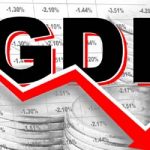 Prof. Raj Kishore Panda*in Bhubaneswar, September 21, 2020: An intense debate is hotting up over the causes of sharp decline in Gross Domestic Product (GDP) to the extent of 23.9 per cent in the first quarter (April-June) of FY 2020-21.
Prof. Raj Kishore Panda*in Bhubaneswar, September 21, 2020: An intense debate is hotting up over the causes of sharp decline in Gross Domestic Product (GDP) to the extent of 23.9 per cent in the first quarter (April-June) of FY 2020-21.
While some experts attribute this to the structural problems with the economy, others connect this to the onslaught of the pandemic-led lockdown. Based on the available data, the first group of experts argue that the current crash in GDP dates back to pre-covid-19 period beginning with 2016-17. The economy witnessed decelerating trend in real GDP growth from 8.2 percent in 2016-17 to 7 percent, in 2017-18, further to 6.1 percent in 2018-19 and 4.2 percent in 2019-20. Quarterly growth rates also reveal a consistent declining trend from 8.2 percent in Q1 of FY2018-19, to 5.00 percent Q1 of 2019-20 and subsequently to 3.1 percent in Q4 of FY2019-20.
In contrast, the other expert group who attribute the present GDP collapse to COVID-19 led lockdown rely largely on current reports of different agencies including media reports exhibiting massive loss in output and employment due to shutting down of businesses and stifling people’s movement etc. In this context, it may be pointed out that as measured by the Oxford Government Response, the lockdown followed by India is considered the most stringent in the world.
It is commonly understood that poor are the hardest hit whenever some untoward situation befalls on an economy. It may be natural calamities like drought and flood or business upturn and downturn -inflation and recession/ depression. As such the present recessionary situation (the consistent and sharp decline in GDP) that has emerged in the economy has impacted severely the poor, the daily labourers, the farmers, the lower middle class of the community. Sectors having higher incidence of labour employment  are severely hit during the lockdown.
are severely hit during the lockdown.
As per the available data, the construction sector is worst hit by the lockdown with (-50.3 percent decline followed by hotels and transport (-47.0 percent), manufacturing (-39.3 percent) and mining and quarrying (-23.3 percent). The services sectors are however found less affected as their negative growth rates remain relatively low. In contrast the farm sector which happens to be labour intensive shows a positive growth performance of 3.4 percent during the period.
This implies that our rural economy is least affected by the lockdown. As such in reviving the economy the farm sector can play a significant role provided no interruption in the economic activity in this sector takes place.
In view of the wide-ranging debate on the decline of GDP numbers, it is very much important for us to know about the composition of GDP and how its various components behave over time so as to have a better understanding of its present awful status. GDP is a sum total of four values such as private consumption, private investment, government expenditures and net exports.
Leaving the government expenditures, all the other three components denote the non-government part of the GDP of an economy. What is observed over time, leaving aside government expenditure all the three other components of GDP have been showing poor growth performance. Sales of all consumer products from cars to biscuits have fallen resulting in investment is more or less stalled in these sectors. Exports are barely growing over the last few years.
There is a limit to the extent government expenditure can drive the economy. In the present situation when the tax collections have started declining, the government should address the slowdown beyond growth stimulating spending. At this juncture a revival cannot be expected following the usual Keynesian way of raising government expenditure.
 Since the present crash in GDP can be attributed largely to structural reasons with COVID-19 led lockdown heightening the crisis there is need for taking some bold reform measures to remove the impediments blocking the economic growth. As it is seen, our agriculture sector continues to suffer from low productivity, low generation of income and putting farmers in a regular debt trap. The sector needs a structural reform.
Since the present crash in GDP can be attributed largely to structural reasons with COVID-19 led lockdown heightening the crisis there is need for taking some bold reform measures to remove the impediments blocking the economic growth. As it is seen, our agriculture sector continues to suffer from low productivity, low generation of income and putting farmers in a regular debt trap. The sector needs a structural reform.
Agriculture had by and large remained outside the economic reforms initiated in 1992. It is now high time to take bold decision to free agriculture sector from the government regulations. No doubt in recent years some policy changes have been adopted. But they are largely piece-meal approach to tide over some immediate issues and hence are not helpful in the context of long-term sustainable growth of the sector. Following the model adopted by the East Asian countries like, Japan, China, South Korea, the small farms need to be made competitive in India.
Besides, in the banking sector the economy faces a serious roadblock to development. Our public sector banks (PSBs) are burdened with massive non-performing assets (NPAs) and crippled by scarcity of capital. Their share in total loans advanced in the country has fallen. Shockingly enough, the share of PSBs in incremental loans has significantly declined from 76 percent in 2012 to about 20 percent in 2019. The argument that PSBs are serving the poor does not hold true.
Going by the data as of now, the corporate borrowing accounts for 51.3 percent of total loans and 78.3 percent of bad loans. This suggests for doing away with state control and regulation on the banks so as to make them perform their intermediary functions with accountability. Prime Minister Narendra Modi has more often than not have been stressing on what he says, “Crisis be converted into opportunities”.
In fact, it is the most opportune time to push through reform measures. The Modi Government must rise to the occasion to herald a new era of bold reforms for a “Better India”.
*Formerly, Professor of Economics, Utkal University & Director, Nabakrushna Choudhury Centre for Development Studies , ( ICSSR Institute) Bhubaneswar.


Leave a Reply
Be the First to Comment!